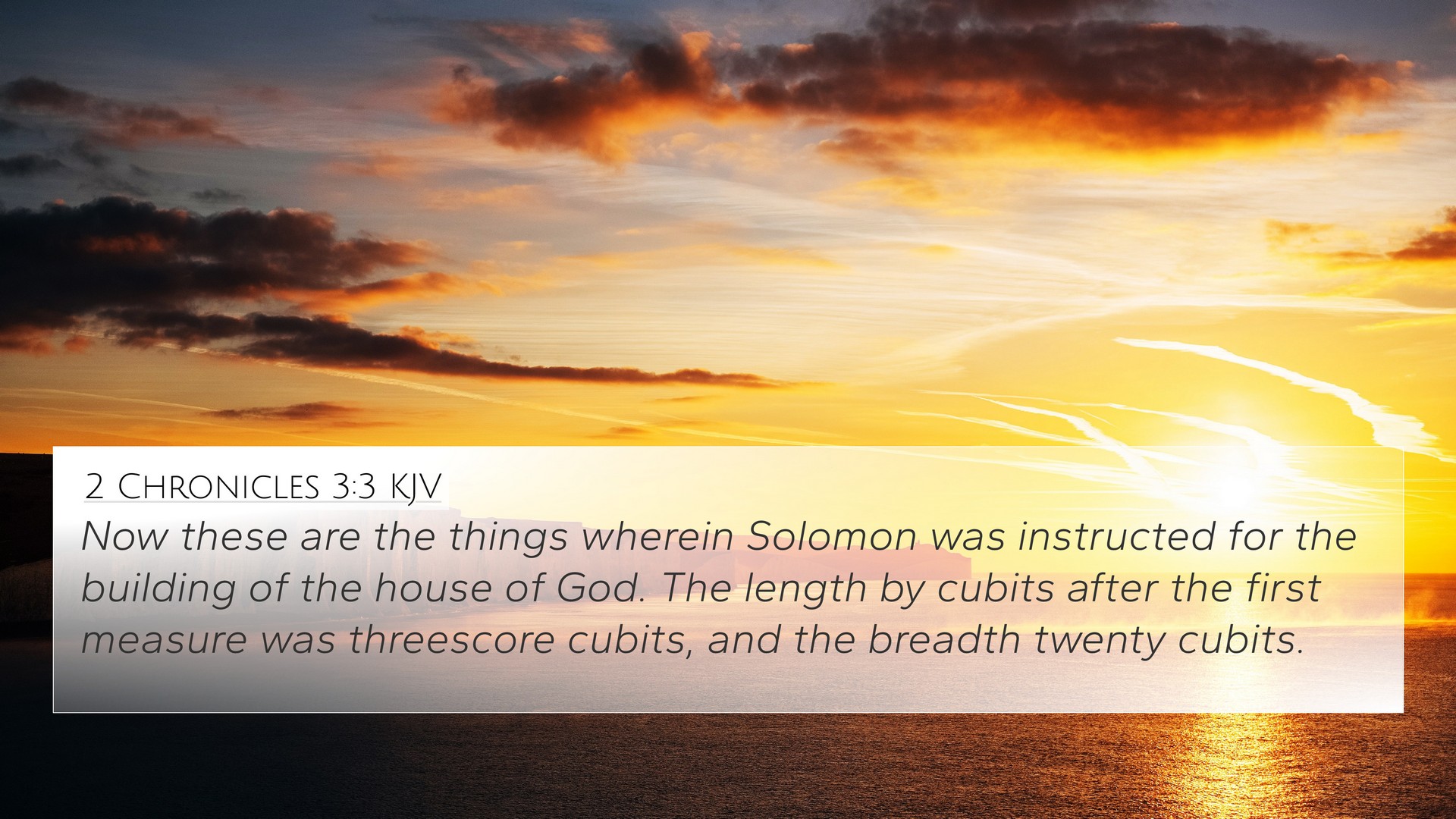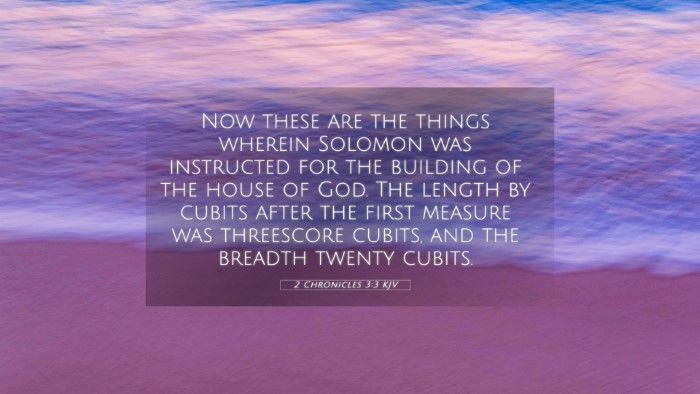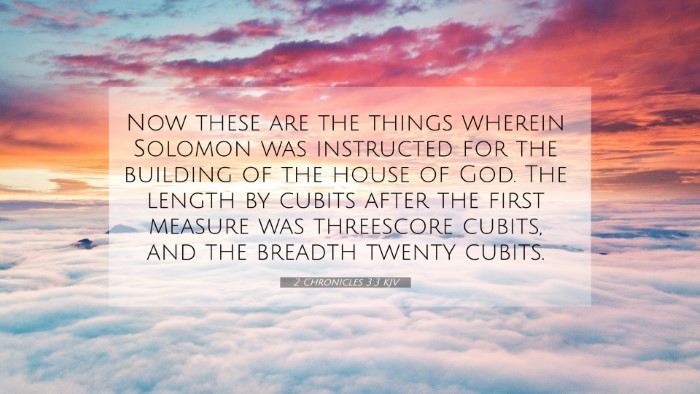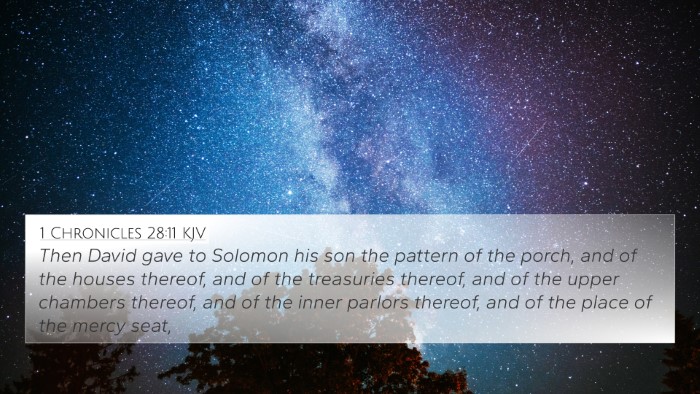Understanding 2 Chronicles 3:3
Verse: "Now these are the things wherein Solomon was instructed for the building of the house of God. The length by cubits after the first measure was threescore cubits, and the breadth twenty cubits." (2 Chronicles 3:3)
Introduction to the Verse Meaning
2 Chronicles 3:3 presents vital information regarding the construction of the temple, highlighting King Solomon's adherence to divine instruction in establishing a sacred space. This act signifies not only the physical building of the temple but also the spiritual and communal significance it holds for the people of Israel. Various public domain commentaries shed light on the deeper meanings embedded within this verse.
Commentary Insights
Matthew Henry's Commentary
Matthew Henry emphasizes the importance of meticulous obedience in performing God’s work. He notes that Solomon received specific directions for the temple's construction, reflecting God's desire for an ordered worship environment. Henry articulates that this attention to detail indicates God's majesty and the seriousness with which the Israelites approached their covenant with Him.
Albert Barnes' Commentary
Albert Barnes points out the dimensions given in this verse demonstrate both grandeur and function, symbolic of God’s presence among His people. He expounds on the dimensions, explaining that the measurements were rooted in earlier temple plans, enabling comparisons with other sites of worship in Israel. Barnes sees these specifics as essential to understanding the theological significance of the temple structure as a place where heaven meets earth.
Adam Clarke's Commentary
Adam Clarke highlights the historical context of Solomon’s temple, explaining its role in Israel's national identity. He provides insights into the significance of building the temple according to God’s design, reflecting a commitment to divine authority and obedience. Clarke also connects the architectural features to broader biblical themes of covenant and worship.
Bible Verse Cross-References
This verse can be effectively linked to several other scriptural passages that enhance its understanding and reveal recurring biblical themes. Below are some notable cross-references:
- 1 Kings 6:2: "And the house which King Solomon built for the Lord was sixty cubits long, twenty cubits wide, and thirty cubits high."
- Exodus 25:8: "And let them make me a sanctuary; that I may dwell among them."
- 2 Samuel 7:12-13: "When your days are fulfilled and you lie down with your fathers, I will set up your offspring after you, who shall come from your body, and I will establish his kingdom. He shall build a house for my name, and I will establish the throne of his kingdom forever."
- Hebrews 8:5: "They serve a copy and shadow of the heavenly things. For when Moses was about to erect the tent, he was instructed by God, saying, 'See that you make everything according to the pattern that was shown you on the mountain.'"
- Psalm 27:4: "One thing have I asked of the Lord, that will I seek after: that I may dwell in the house of the Lord all the days of my life, to gaze upon the beauty of the Lord and to inquire in His temple."
- Isaiah 66:1: "Thus says the Lord: Heaven is my throne, and the earth is my footstool; what is the house that you would build for me, and what is the place of my rest?"
- 1 Corinthians 3:16: "Do you not know that you are God’s temple and that God’s Spirit dwells in you?"
Connecting Themes and Cross-Referencing
The relationships among these scriptures highlight the intricate tapestry of God’s plan for His people and their worship. Themes of obedience, divine presence, and sacred architecture run throughout the Bible, confirming the importance of the temple not just as a structure but as a representation of God's relationship with His people. Such cross-referencing provides deeper insights into how the Old and New Testaments interact.
Conclusion
The examination of 2 Chronicles 3:3 through the lens of prominent biblical commentaries reveals the multi-layered significance of Solomon’s temple. It is a profound reminder of the importance of following divine instruction and the need for a sanctuary for worship, resonating with countless scripture connections throughout the Bible.
For Further Study
For those interested in delving deeper into the connections between Bible verses, various tools and resources are available:
- Bible Concordance: Useful for searching specific terms or themes across scripture.
- Bible Cross-Reference Guide: Helps in identifying links between passages.
- Cross-Reference Bible Study: Encourages exploration of biblical texts for thematic connections.
- Bible Reference Resources: Comprehensive materials for deeper understanding.




